ANGLE RELATIONSHIPS IN PARALLEL LINES AND TRIANGLES
Angle Pairs Formed by a Transversal
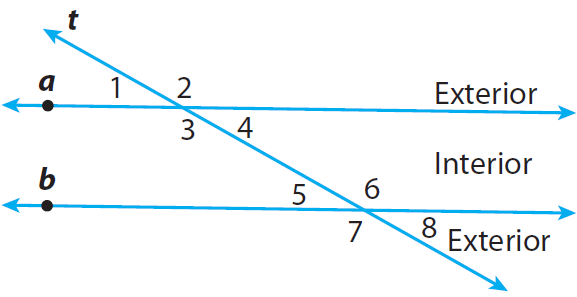
Corresponding Angles :
Angles lie on the same side of the transversal t, on the same side of lines a and b.
Example : ∠ 1 and ∠ 5.
Alternate Interior Angles :
Angles are nonadjacent angles that lie on opposite sides of the transversal t, between lines a and b.
Example : ∠ 3 and ∠ 6.
Alternate Exterior Angles :
Angles lie on opposite sides of the transversal t, outside lines a and b.
Example : ∠ 1 and ∠ 8.
Same-Side Interior Angles :
Angles lie on the same side of the transversal t, between lines a and b.
Example : ∠ 3 and ∠ 5.
Angle Relationships in Triangles
In this section, we are going to see the angle relationships in triangles through the following steps.
Step 1 :
Draw a triangle and cut it out. Label the angles A, B, and C.
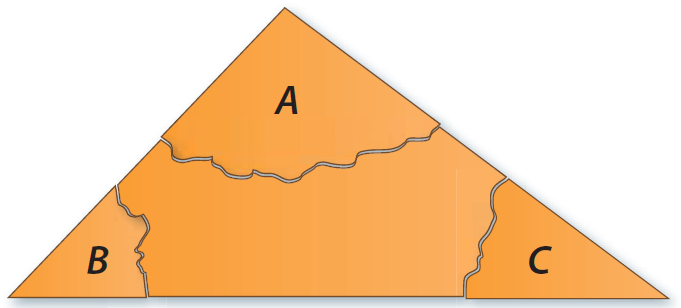
Step 2 :
Tear off each “corner” of the triangle. Each corner includes the vertex of one angle of the triangle.
Step 3 :
Arrange the vertices of the triangle around a point so that none of your corners overlap and there are no gaps between them.
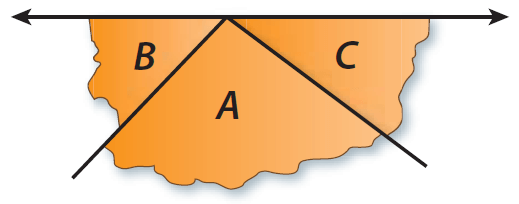
Step 4 :
What do you notice about how the angles fit together around a point ?
The angles form a straight angle.
Step 5 :
What do you notice about how the angles fit together around a point ?
180°
Step 6 :
Describe the relationship among the measures of the angles of triangle ABC ?
The sum of the angle measures is 180°.
Step 7 :
What does the triangle sum theorem state ?
The triangle sum theorem states that for triangle ABC,
m∠A + m∠B + m∠C = 180°
Exterior Angle Theorem in Triangles
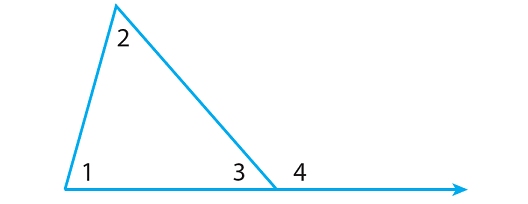
The theorem states that the measure of an exterior angle is equal to the sum of its remote interior angles.
That is,
m∠1 + m∠2 = m∠4
Solved Problems
Problem 1 :
In the figure given below, let the lines l₁ and l₂ be parallel and m is transversal. If ∠F = 65°, find the measure of each of the remaining angles.
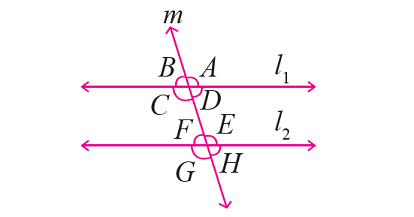
Solution :
From the given figure,
∠F and ∠H are vertically opposite angles and they are equal.
Then,
∠H = ∠F ----> ∠H = 65°
∠H and ∠D are corresponding angles and they are equal.
Then,
∠D = ∠H ----> ∠D = 65°
∠D and ∠B are vertically opposite angles and they are equal.
Then,
∠B = ∠D ----> ∠B = 65°
∠F and ∠E are together form a straight angle.
Then, we have
∠F + ∠E = 180°
Substitute ∠F = 65°.
∠F + ∠E = 180°
65° + ∠E = 180°
∠E = 115°
∠E and ∠G are vertically opposite angles and they are equal.
Then,
∠G = ∠E ----> ∠G = 115°
∠G and ∠C are corresponding angles and they are equal.
Then,
∠C = ∠G ----> ∠C = 115°
∠C and ∠A are vertically opposite angles and they are equal.
Then,
∠A = ∠C ----> ∠A = 115°
Therefore,
∠A = ∠C = ∠E = ∠G = 115°
∠B = ∠D = ∠F = ∠H = 65°
Problem 2 :
In a triangle, if the second angle is 5° greater than the first angle and the third angle is 5° greater than second angle, find the three angles of the triangle.
Solution :
Let x be the first angle.
The second angle = x + 5.
The third angle = x + 5 + 5 = x + 10.
We know that,
the sum of the three angles of a triangle = 180°
x + (x + 5) + (x + 10) = 180
3x + 15 = 180
3x = 165
x = 55
The first angle = 55°.
The second angle = 55 + 5 = 60°.
The third angle = 60 + 5 = 65°.
So, the three angles of a triangle are 55°, 60° and 65°.
Problem 3 :
Find m∠W and m∠X in the triangle given below.

Solution :
Step 1 :
Write the Exterior Angle Theorem as it applies to this triangle.
m∠W + m∠X = m∠WYZ
Step 2 :
Substitute the given angle measures.
(4y - 4)° + 3y° = 52°
Step 3 :
Solve the equation for y.
(4y - 4)° + 3y° = 52°
4y - 4 + 3y = 52
Combine the like terms.
7y - 4 = 52
Add 4 to both sides.
7y - 4 + 4 = 52 + 4
Simplify.
7y = 56
Divide both sides by 7.
y = 8
Step 4 :
Use the value of y to find m∠W and m∠X.
m∠W = 4y - 4
= 4(8) - 4
= 32 - 4
= 28
m∠X = 3y
= 3(8)
= 24
So, m∠W = 28° and m∠X = 24°.
Kindly mail your feedback to v4formath@gmail.com
We always appreciate your feedback.
©All rights reserved. onlinemath4all.com
Recent Articles
-
Digital SAT Math Problems and Solutions (Part - 144)
Apr 14, 25 07:27 PM
Digital SAT Math Problems and Solutions (Part - 144) -
Quadratic Equation Problems with Solutions (Part - 1)
Apr 14, 25 11:33 AM
Quadratic Equation Problems with Solutions (Part - 1) -
Quadratic Equation Problems with Solutions (Part - 2)
Apr 14, 25 11:22 AM
Quadratic Equation Problems with Solutions (Part - 2)
